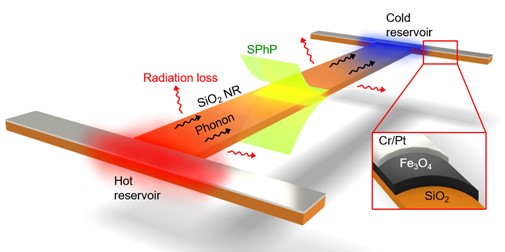Surface phonon polaritons enhance thermal conductivity

Materials with high thermal conductivity are sought after for use in electronic devices because they swiftly remove excess heat, allowing for optimal performance. However, as devices become smaller and run faster, removing heat is becoming increasingly challenging.
Recent studies have suggested that surface phonon polaritons (SPhPs) – quasiparticles that arise from the coupling between phonons and photons – could enhance thermal conductivity in certain materials. Now, researchers at the University of California San Diego have demonstrated this for the first time in silicon dioxide nanoribbon waveguides.
SPhPs are particle-like excitations that occur at the surface of certain materials, specifically polar dielectrics. They are formed by the interaction between quantized oscillations of the crystal lattice (phonons) and electromagnetic waves (photons). SPhPs can transport large quantities of heat along the surface of a material owing to their phonon component. However, the photonic nature of SPhPs means that their mean free path of propagation is much longer than uncoupled phonons. This makes SPhPs an ideal candidate for long-range heat transport. Some recent research provides evidence for this enhancement, and now San Diego’s Yu Pei and colleagues have made the first unambiguous demonstration of thermal conductivity enhancement by SPhPs.
Hot and cold reservoirs
The team built a device comprising two parallel silicon dioxide rails connected by a narrower silicon dioxide waveguide in a configuration that resembles the letter H (see figure). The silicon dioxide rails acted as hot and a cold thermal reservoirs. These were coated with a layer of platinum, allowing the hot reservoir to act and a heater and the cold reservoir as a temperature sensor.
Through mathematical modelling, the researchers showed that the SPhP propagation length increased with decreasing waveguide thickness, reaching a remarkable maximum length of more than 1 cm. This is because, in thinner waveguides, a larger proportion of the mode volume exists in the vacuum and experiences no loss.
Initially, however, this larger mode volume presented two problems for the researchers. It increased leakage of the SPhPs into the surrounding substrate; and it reduced coupling between the waveguide and the thermal reservoirs. To circumvent these problems, two special features were incorporated into the nanoribbon design. The waveguide and reservoirs were suspended above the substrate to reduce overlap between the SPhP mode and the substrate, reducing leakage. Also, an absorbing layer of black oxide (Fe3O4) was sandwiched between the silicon dioxide rails and the platinum layer to facilitate the absorption of the SPhPs by the thermal reservoirs.
Black oxide is crucial
To determine the effect of the SPhPs and the device design on thermal transport, the team heated the hot reservoir by applying a voltage to the platinum and measured the temperature rise in both reservoirs. They showed that samples without the layer of black oxide exhibited had conductivity typical of that mediated by uncoupled phonons. When the black oxide was present, however, the thermal conductivity was enhanced by up to 34% compared to bulk silicon dioxide. This suggests that the black oxide is crucial to the transport of heat by SPhPs from the waveguide to the reservoir and that heat cannot be effectively absorbed without this layer.

Exciton–polaritons enhance magneto-optical responses in van der Waals crystals
Pei and colleagues also found evidence of ballistic heat transport, demonstrating that the thermal conductivity of thicker, wider nanoribbons was not affected by increasing the length of the waveguide from 49 micron to 99 micron. Comparing this to the mean free path of uncoupled phonons, which tends to be 1 micron or less, it is easy to see the impact that SPhPs could have on heat transport in nanoelectronics and microelectronics. The team also showed that, when the nanoribbons were smaller than the SPhP wavelength in 1D or 2D, they exhibited two- and one-dimensional temperature dependence, respectively. Such a heat conduction regime has been sought for nearly two decades.
These results represent a real breakthrough for microelectronics, nanophotonics and further fundamental studies into heat transport and SPhPs. Through careful waveguide design and a specific focus on mode volume and coupling into the thermal reservoirs, the researchers demonstrated SPhP-enhanced thermal conductivity with 1D and 2D temperature dependence, both for the first time. This will open the road towards the study of low-dimensional and quantum heat conductance at high temperatures, and, with additional optimization of the nanoribbon design, further enhancement of thermal conductivity should be possible.
The research is described in Nature Communications.






